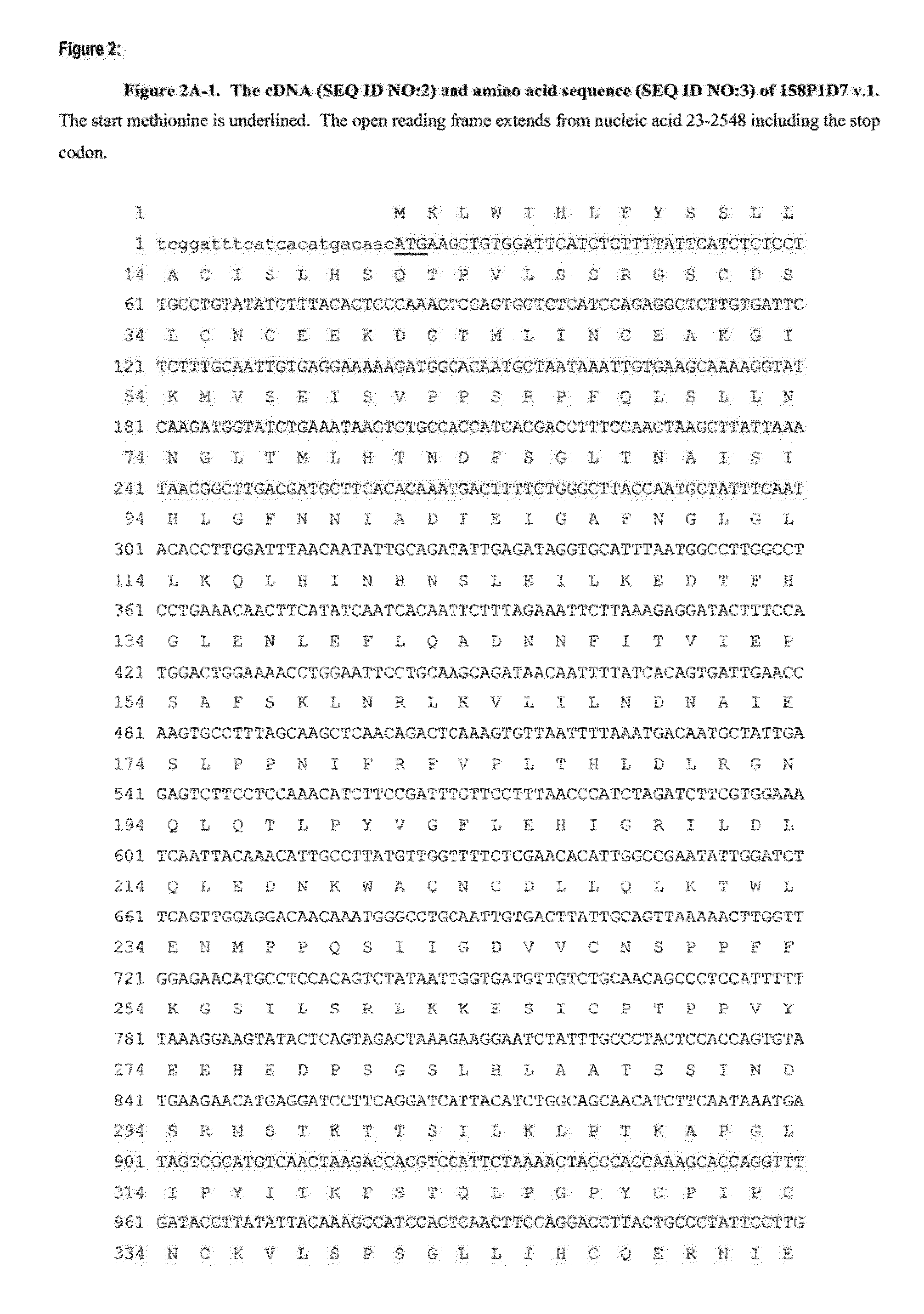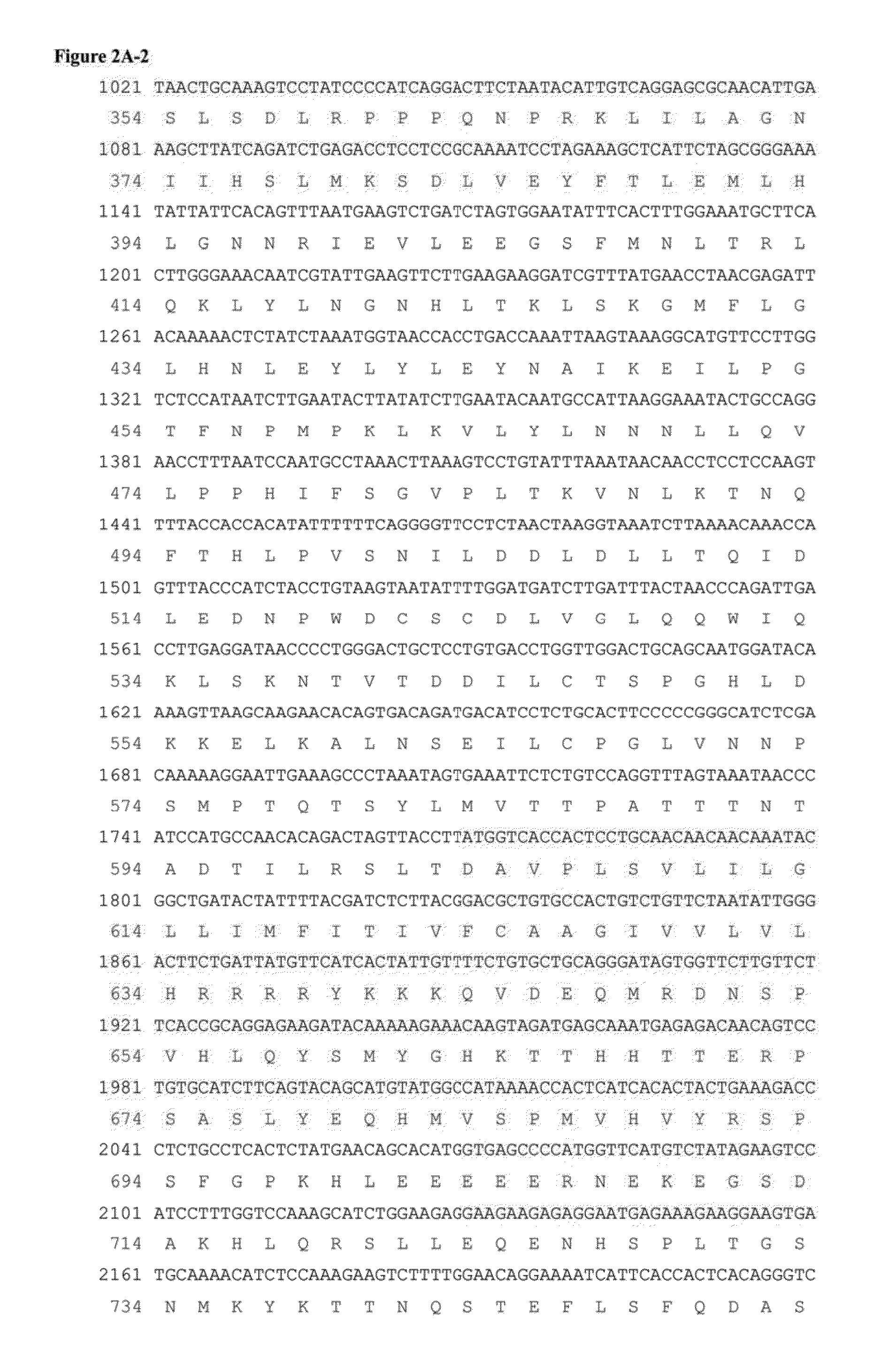Nucleic acid and corresponding protein named 158p1d7 useful in the treatment and detection of bladder and other cancers
a technology of nucleic acid and corresponding protein, applied in the field of new nucleic acid sequences and their encoded proteins, can solve the problems of increasing problems, poor sensitivity of methods, and increasing incidence and mortality of bladder cancer, and achieve the effect of inhibiting transcription, translation, processing or function
- Summary
- Abstract
- Description
- Claims
- Application Information
AI Technical Summary
Benefits of technology
Problems solved by technology
Method used
Image
Examples
example 1
SSH-Generated Isolation of a cDNA Fragment of the 158P1D7 Gene
[0461]To isolate genes that are over-expressed in bladder cancer we used the Suppression Subtractive Hybridization (SSH) procedure using cDNA derived from bladder cancer tissues, including invasive transitional cell carcinoma. The 158P1D7 SSH cDNA sequence was derived from a bladder cancer pool minus normal bladder cDNA subtraction. Included in the driver were also cDNAs derived from 9 other normal tissues. The 158P1D7 cDNA was identified as highly expressed in the bladder cancer tissue pool, with lower expression seen in a restricted set of normal tissues.
[0462]The SSH DNA sequence of 231 bp (FIG. 1) has high homology (230 / 231 identity) to a hypothetical protein FLJ22774 (GenBank accession XM—033183) derived from a chromosome 13 genomic clone. A 158P1D7 cDNA clone (TurboScript3PX) of 2,555 bp was isolated from bladder cancer cDNA, revealing an ORF of 841 amino acids (FIG. 2 and FIG. 3).
[0463]The 158P1D7 protein has a sig...
example 2
Full Length Cloning of 158P1D7
[0487]The 158P1D7 SSH cDNA sequence was derived from a bladder cancer pool minus normal bladder cDNA subtraction. The SSH cDNA sequence (FIG. 1) was designated 158P1D7. The full-length cDNA clone 158P1D7-clone TurboScript3PX (FIG. 2) was cloned from bladder cancer pool cDNA.
[0488]158P1D7 clone cDNA was deposited under the terms of the Budapest Treaty on 22 Aug. 2001, with the American Type Culture Collection (ATCC; 10801 University Blvd., Manassas, Va. 20110-2209 USA) as plasmid p158P1D7-Turbo / 3PX, and has been assigned Accession No. PTA-3662.
example 3
Chromosomal Mapping of 158P1D7
[0489]Chromosomal localization can implicate genes in disease pathogenesis. Several chromosome mapping approaches are available including fluorescent in situ hybridization (FISH), human / hamster radiation hybrid (RH) panels (Walter et al., 1994; Nature Genetics 7:22; Research Genetics, Huntsville Ala.), human-rodent somatic cell hybrid panels such as is available from the Coriell Institute (Camden, N.J.), and genomic viewers utilizing BLAST homologies to sequenced and mapped genomic clones (NCBI, Bethesda, Md.).
[0490]158P1D7 maps to chromosome 13, using 158P1D7 sequence and the NCBI BLAST tool. This is a region of frequent amplification in bladder cancer (Prat et al., Urology 2001 May; 57(5):986-92; Muscheck et al., Carcinogenesis 2000 September; 21(9):1721-26) and is associated with rapid tumor cell proliferation in advanced bladder cancer (Tomovska et al., Int J Oncol 2001 June; 18(6):1239-44).
PUM
| Property | Measurement | Unit |
|---|---|---|
| diameter | aaaaa | aaaaa |
| volume | aaaaa | aaaaa |
| temperature | aaaaa | aaaaa |
Abstract
Description
Claims
Application Information
 Login to View More
Login to View More - R&D
- Intellectual Property
- Life Sciences
- Materials
- Tech Scout
- Unparalleled Data Quality
- Higher Quality Content
- 60% Fewer Hallucinations
Browse by: Latest US Patents, China's latest patents, Technical Efficacy Thesaurus, Application Domain, Technology Topic, Popular Technical Reports.
© 2025 PatSnap. All rights reserved.Legal|Privacy policy|Modern Slavery Act Transparency Statement|Sitemap|About US| Contact US: help@patsnap.com



